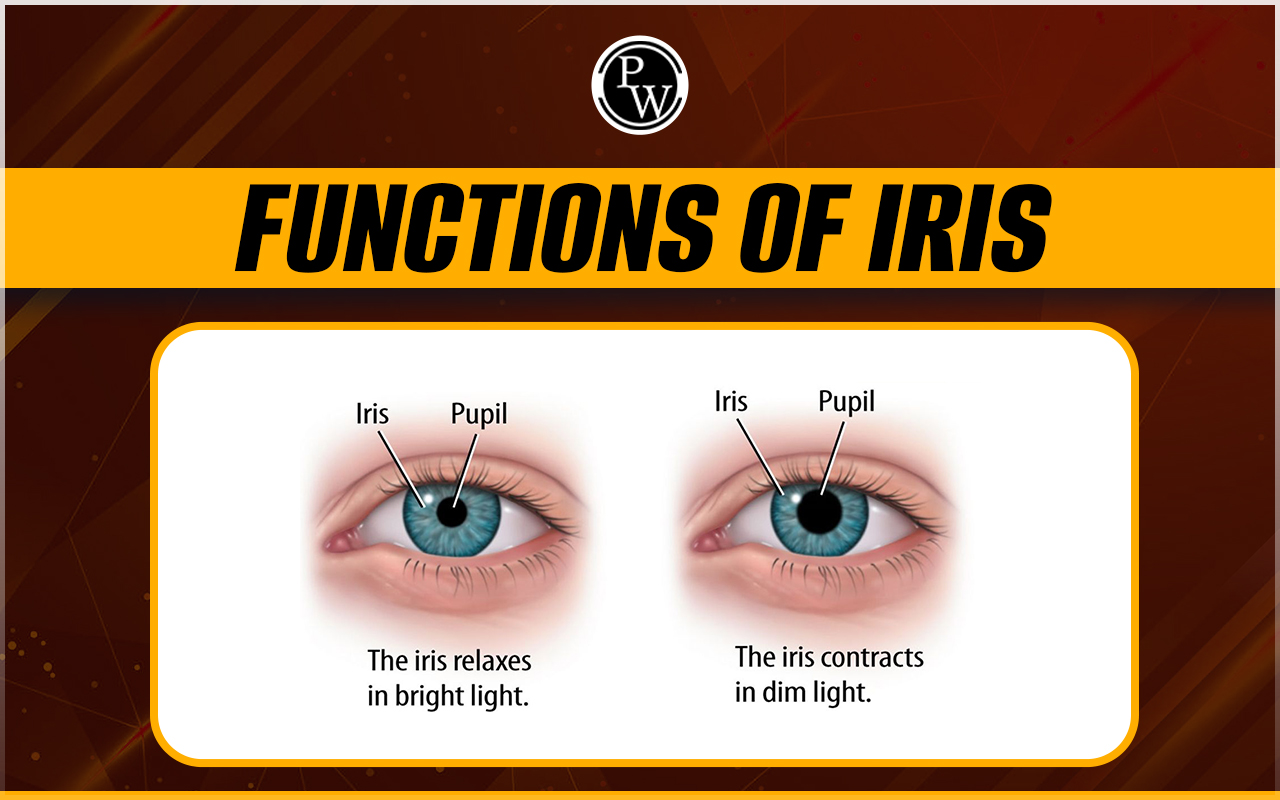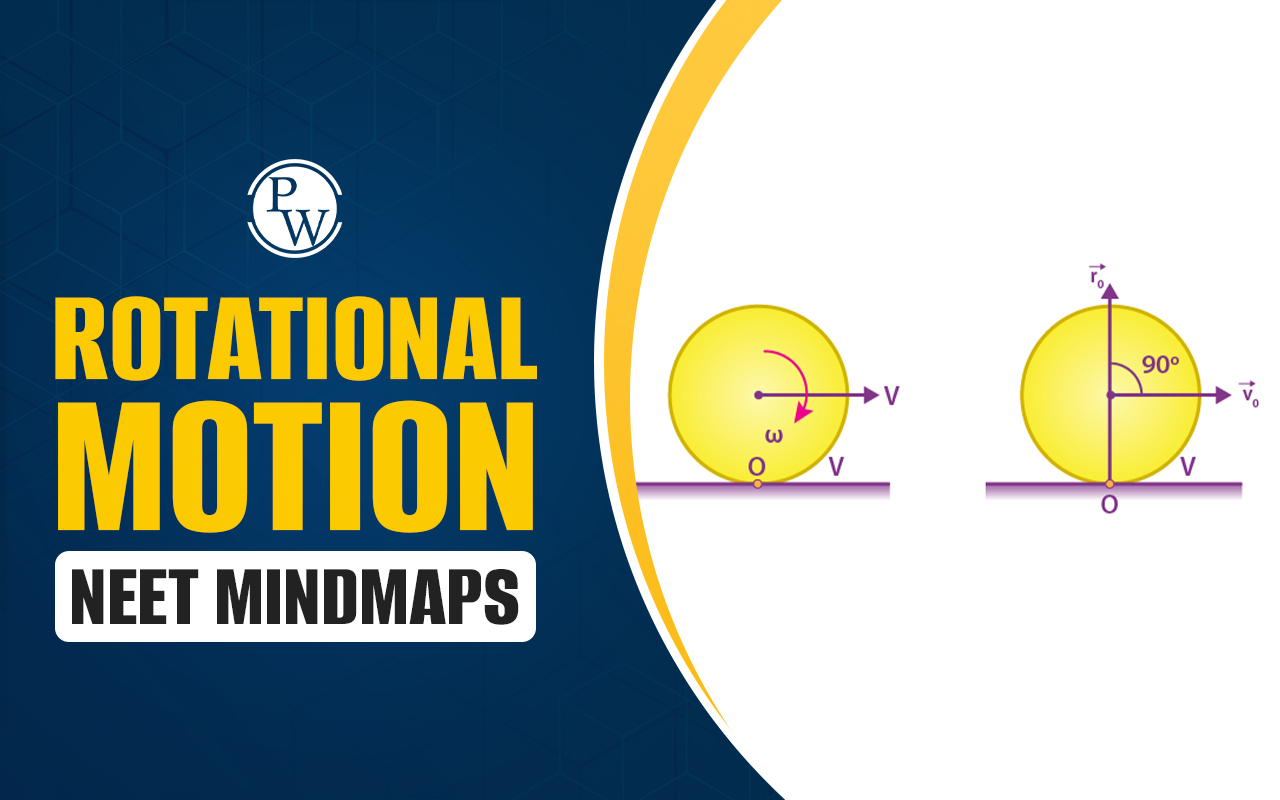

Functions of Iris: The iris is a thin, pigmented structure in the eye that regulates the amount of light that enters the retina and determines eye color. The iris, located in the front of the eye, regulates the size and diameter of the pupil, controlling the amount of light that enters the eye. It is the visible, pigmented, and opaque part of the eye.
The muscles of the iris adjust the pupil size: when the light is bright, the iris constricts the pupil to reduce light intake, and when the light is dim, it dilates the pupil to allow more light in. The iris is part of the pigmented or vascular layer and is a dark, round structure found beneath the cornea. For more details on the functions of the iris, students can refer to the article below.Also Check:
What are Iris?
The iris, the colored part of the eye, contains muscles that regulate the pupil, the small black opening that allows light to enter the eye. The color of the iris is unique to each individual, akin to a fingerprint, with no one else in the world possessing the exact same eye color. The iris works with the rest of the eye to improve vision by regulating the amount of light that enters. Muscles in the iris automatically adjust the pupil size in response to changes in lighting. When the pupil dilates, more light enters the eye; when it contracts, less light is allowed in.Also Check:
The iris regulates the size of the pupil to control how much light enters the inner parts of the eye. This continuous adjustment aids vision in a variety of lighting conditions and operates without conscious control. This change can be seen when transitioning from a bright outdoor environment to a dim indoor setting. The iris adjusts the pupil size, which is why it takes time for the eyes to adapt to different light levels.Structure of Iris
The iris is a thin, circular structure in the eye that controls the size of the pupil, thereby regulating the amount of light entering the eye. It is the colored part of your eye.| NEET Biology Notes | |||
|---|---|---|---|
| Embryo | Funaria | Selaginella | Malvaceae |
| Polyembryony | Apomixis | Pinus | Pollen Grains |
| Chara | Volvox | Endosperm | Equisetum |
Layers of the Iris
The iris consists of two primary layers:-
Stroma
: The front layer, consisting of connective tissue, blood vessels, and two types of muscles:
- Sphincter Pupillae : A circular muscle that contracts the pupil in strong light.
- Dilator Pupillae : A radial muscle that dilates the pupil in low light.
- Pigmented Epithelium : The back layer, which contains pigment-producing cells that give the iris its color.
How the Iris Works
The iris functions similarly to a camera aperture, adjusting the size of the pupil to control the amount of light reaching the retina.- Bright Light : In bright light, the sphincter pupillae contract, causing the pupil to constrict. This decreases the amount of light entering the eye, shielding the retina from harm.
- Dim Light : In low-light conditions, the dilator pupillae contract, causing the pupil to dilate. This allows more light to enter the eye, enhancing vision in dim environments.
| NEET Biology Notes | ||
|---|---|---|
| Plasma Membrane Structure | Pre-Fertilisation | Economic Importance of Algae |
| Slime moulds | hypotonic solution | Post fertilisation |
Functions of Iris
The iris is an essential structure in the human eye, playing an important role in regulating the amount of light that enters the eye. The following are the important functions of Iris in the human body:- Regulation of Light Entry: Pupil Size Adjustment: The primary function of the iris is to control the diameter and size of the pupil. This adjustment controls how much light enters the eye. The sphincter pupillae muscle constricts the pupil in bright light (miosis) to reduce light entry, while the dilator pupillae muscle dilates the pupil in dim light (mydriasis) to increase light entry. This process is referred to as the pupillary light reflex.
- Protection of the Retina: By adjusting the pupil size, the iris protects the retina from excessive light that can cause damage. In bright conditions, the constriction of the pupil helps prevent phototoxicity, whereas dilation in low-light conditions ensures that enough light reaches the retina for clear vision.
- Improvement of Visual Acuity: The iris helps improve visual acuity by controlling the amount of light that reaches the retina, reducing glare and enhancing focus. This function is particularly important in maintaining sharp vision in various lighting conditions.
- Color and Aesthetic Function: The iris gives the eye its color, which is determined by the density and distribution of melanin pigment within the pigment epithelium and stroma. While this does not affect vision directly, it has an aesthetic and social significance.
- Autonomic Nervous System Interaction: The iris muscles are controlled by the autonomic nervous system. The parasympathetic nervous system controls the sphincter pupillae muscle, leading to pupil constriction, while the sympathetic nervous system controls the dilator pupillae muscle, causing pupil dilation. This interaction allows the eye to respond rapidly to changes in lighting and emotional states.
| NEET Biology Notes | |||
|---|---|---|---|
| Rhizopus | Fibrous root | Marchantia | Actinomycetes |
| Nostoc | Spirogyra | Ribosomes | Liverworts |
Functions of Iris FAQs
Q1: What color is the human iris?
Ans. The color of the human iris can range from black to light brown. This variation is due to the concentration of melanin in the iris pigment epithelium, the melanin content in the iris stroma, and the density of the stroma's cellular structure.
Q2: What is the purpose of the iris?
Ans. The iris is the colorful area of the eye that surrounds the pupil. Its principal job is to regulate the amount of light entering the eye. It changes the size of the pupil, regulating light exposure to the retina.
Q3: What are the two layers of the iris?
Ans. The iris has two main layers: the stroma and the pigmented epithelial cells. The stroma is the front layer, which is pigmented and contains fibrous and vascular tissue. Beneath the stroma lies the layer of pigmented epithelial cells.
Q4: What are the three functions of the iris?
Ans. The iris serves three key functions: it regulates the amount of light entering the eye by adjusting the size of the pupil, determines the eye color, and is located in front of the lens. By controlling pupil size, the iris manages light exposure to the retina.
Q5: What is the function of the iris muscle?
Ans. The iris muscle surrounds the pupil and functions to constrict the pupil in bright light through the pupillary light reflex or during accommodation. By adjusting the pupil's diameter, the iris controls the amount of light reaching the retina.
Q6: What is the major function of the cornea?
Ans. The cornea protects the eye from external debris and ultraviolet light. It is responsible for 65% to 75% of the eye's light refraction. The cornea performs the initial bending of light, which is then further focused by the lens onto the retina.
Talk to a counsellorHave doubts? Our support team will be happy to assist you!

Free Learning Resources
PW Books
Notes (Class 10-12)
PW Study Materials
Notes (Class 6-9)
Ncert Solutions
Govt Exams
Class 6th to 12th Online Courses
Govt Job Exams Courses
UPSC Coaching
Defence Exam Coaching
Gate Exam Coaching
Other Exams
Know about Physics Wallah
Physics Wallah is an Indian edtech platform that provides accessible & comprehensive learning experiences to students from Class 6th to postgraduate level. We also provide extensive NCERT solutions, sample paper, NEET, JEE Mains, BITSAT previous year papers & more such resources to students. Physics Wallah also caters to over 3.5 million registered students and over 78 lakh+ Youtube subscribers with 4.8 rating on its app.
We Stand Out because
We provide students with intensive courses with India’s qualified & experienced faculties & mentors. PW strives to make the learning experience comprehensive and accessible for students of all sections of society. We believe in empowering every single student who couldn't dream of a good career in engineering and medical field earlier.
Our Key Focus Areas
Physics Wallah's main focus is to make the learning experience as economical as possible for all students. With our affordable courses like Lakshya, Udaan and Arjuna and many others, we have been able to provide a platform for lakhs of aspirants. From providing Chemistry, Maths, Physics formula to giving e-books of eminent authors like RD Sharma, RS Aggarwal and Lakhmir Singh, PW focuses on every single student's need for preparation.
What Makes Us Different
Physics Wallah strives to develop a comprehensive pedagogical structure for students, where they get a state-of-the-art learning experience with study material and resources. Apart from catering students preparing for JEE Mains and NEET, PW also provides study material for each state board like Uttar Pradesh, Bihar, and others
Copyright © 2025 Physicswallah Limited All rights reserved.











